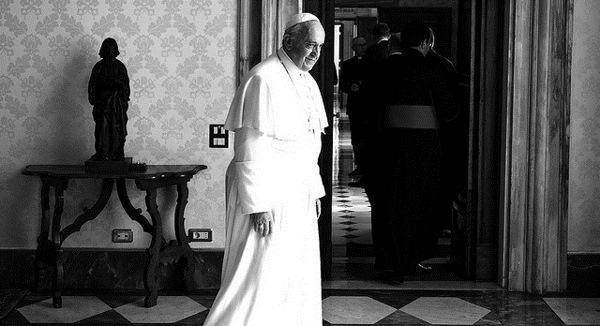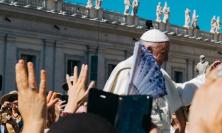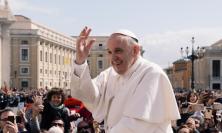How many conspiracy theories about Pope Francis have you heard? It’s likely that you have come across at least one, and if your natural reaction was to dismiss it out of hand, perhaps you’ve missed a trick. The author of a new book on the Pope’s ‘not-so-cultured despisers’ argues that such narratives have a sociological significance and require our attention if we are to understand the phenomenon of Pope Francis.
Surely nobody following Church developments since the election of Pope Francis in March 2013 with even moderate attention can have failed to notice that a major characteristic of his Pontificate thus far has been the perhaps unparalleled polarisation of opinion, in and outside Catholicism, concerning the present holder of the Petrine Office. While his rapturous American reception in September indicated the Pope’s unflagging popularity on the world stage, the rise of a strange and disturbing parallel phenomenon also needs to be acknowledged: statements from a growing number of those professing to be Christians that Pope Francis is variously a Communist infiltrator, doctrinal pyromaniac or even the False Prophet of the Apocalypse. For those readers who may think I exaggerate, let me suggest a brief exercise in ‘applied sociology of religion’. First type ‘Pope Francis False Prophet’ into an internet video search engine. Sort results by number of views. You may well be surprised to discover the size of the audience for conspiratorial narratives concerning Jorge Mario Bergoglio. If you then re-shuffle the results by publication date you will also realise that such narratives are proliferating rapidly, the latest trigger being the Pope’s January 2016 video expressing his prayer intentions regarding inter-religious dialogue. If you can stomach it, complete this little exercise by watching a few minutes of the latest anti-Francis videos and measuring the distance of your jaw from the floor.
Much of this anti-Papal invective is naturally extremely crude, and the first reaction to it might be simple amusement at what any thinking viewer ought to be able to dismiss as nothing more than the latest ‘urban legend’. I would, however, like to contend that such a reaction, though understandable, would be mistaken on several counts.
Firstly, that this material is manifest nonsense is unfortunately anything but self-evident. Far too many of us probably know at least one colleague, friend or family member adhering to conspiracy theories absorbed from ‘alternative’ information sources such as the infamous InfoWars news site of American right-wing activist Alex Jones. This is no laughing matter inasmuch that allowing one’s worldview to be moulded by such new mythologies can have extremely damaging psychological and relational consequences. Conspiracy theories are truly habit-forming and obsession-inducing, substantial amounts of mental and emotional energy being required in order to maintain belief in them when faced with external reality. Considerable cognitive dissonance is provoked when conspiracy theories’ frequent grain of truth (after all, human beings do conspire) is confronted with real-life evidence apparently contradicting the theory, and dealing with this dissonance comes at a price.
Once accepted as interpretive frameworks for understanding the world, conspiratorial narratives often estrange their advocates from those around them, with whom they no longer have a shared logic facilitating two-way communication. My guess is that many of us feel powerless to converse rationally with such individuals and attempt to avoid them whenever possible. Mutual exasperation is guaranteed whenever certain subjects are broached, not primarily because our opinions differ, but rather because our understandings of what constitutes reasoned discourse are incompatible. It is truly difficult when someone tells you with a straight face that your views are the result of brainwashing by a CIA mind control programme (or for that matter by Jesuit propaganda, which for some conspiracy theorists amounts to the same thing). Implicit in the popular rise of the conspiratorial mindset is a crisis of rationality, which in itself is a social phenomenon requiring serious investigation.
Secondly, while many ‘alternative media’ sources portraying a Pope Francis in league with the Antichrist may strike readers of Thinking Faith as primitive or culturally alien, this should not blind us to their sociological impact or significance as barometers of our times. Our reading habits and professional activities can sometimes delude us into thinking that not only the world but also the universal Church consists solely of those holding advanced degrees, but to ignore the very real importance of ‘popular religion’ is at best to hold a naïve view of the religious practice of 95% of the world’s Christians and at worst to engage in culpable intellectual snobbery. In largely neglecting popular piety as an object of serious study, academic theology bears some responsibility for the fact that fundamentalist religious narratives within Christianity have gone largely unchecked in recent years. This is an ethical as well as an intellectual issue: it is worth remembering that ‘instructing the ignorant’ (rather than sneering at them from a distance or simply refusing to engage with them) is one of the seven works of spiritual mercy highlighted by Francis in this Jubilee Year. Herein definitely lies what might be politely termed a ‘growth opportunity’: broadly speaking, the academic theological community has neither been able to make itself intelligible to a broad audience nor to dialogue constructively and respectfully with those who are far more likely to consult World Net Daily or Matt Drudge than First Things or Communio. Initiating such dialogue is challenging, because it is clearly insufficient to attempt to ‘instruct the ignorant’ using thought-categories and vocabulary which they cannot understand: any successful pedagogical approach must begin from within their paradigms, a translation requiring much effort as well as unfashionable intellectual humility.
Thirdly, although much current anti-Francis diatribe stems from a distinctly ‘low-brow’ U.S. fundamentalist Evangelical constituency unfortunately still prone to unreconstructed anti-Catholicism, the attribution of conspiratorial intentions to the Pope also characterises a surprising number of Catholic sources other than the ‘usual suspects’, i.e. confirmed enemies of Vatican II. These vary from the overtly defiant, such as the well-known Italian journalist Antonio Socci (whose 2014 book Non è Francesco openly proclaimed Pope Francis’ election to have been technically illegitimate) or Franciscan Br Alexis Bugnolo’s blog From Rome, to the more subtly disgruntled pronouncements of the doggedly conservative Rorate-Caeli or the widely-followed Lifesitenews. Nor are Catholic commentators embedded within mainstream media immune to viewing the Pope as a ‘plotter’, as was recently demonstrated by the acrimonious dispute between many American Catholic academics and New York Times columnist Ross Douthat following the publication of his 17 October 2015 article entitled ‘The Plot to change Catholicism’ during the Synod on the Family. I leave it to others to tackle the rights and wrongs of the ongoing spat between Douthat and his critics, but I would like to highlight some more general questions needing to be asked regarding this intensifying anti-Papal backlash and the unprecedented severity of its language. Why has this emerged now? What were the conditions of possibility for its emergence and – perhaps most intriguingly – why have Pope Francis’ detractors surfaced simultaneously in constituencies which at first glance would appear totally heterogeneous, but which find themselves in an ad hoc convergence whose very improbability requires explanation?
Here one major contributory factor is surely the role of the internet and social media in the instantaneous propagation of ideas, however wild and unsubstantiated. Blogs, Wikileaks, Facebook and Twitter have proved themselves hugely powerful tools for creating a cultural climate in which anyone can say virtually anything about anyone – including the Pope – with more or less total impunity, reaching a global audience within seconds. This is a profound sociological shift with immense and unpredictable ramifications for the dissemination of ‘information’, creating a situation as volatile as that engendered by the invention of the printing press just prior to the Reformation, as the late Phyllis Tickle noted in her controversial but highly observant book The Great Emergence (Grand Rapids: Baker, 2008). The determined internet blogger – whether hosted by a major media outlet, such as Douthat, or a ‘lone ranger’, such as Socci or Bugnolo – can now effectively create a personal virtual fortress for ideas whose impact would often appear to be directly proportionate to their degree of sensationalism.
There is, however, also a second major factor driving many of the promoters of the ‘Pope Francis as False Prophet’ narrative, and which is as much of a taboo subject for academic theology as is popular religion: eschatology. It is a fact that many of Jorge Mario Bergoglio’s most vociferous critics are primarily appealing to tendentious interpretations either of Biblical prophecy, private post-Biblical ‘revelation’ (most notably the disputed ‘St Malachy’ prophecy or ‘Prophecy of the Popes’) or else a combination of both. Perhaps the most puzzling figure in this respect is Catholic theologian Kelly Bowring, whose unashamed assertion that Pope Francis is most probably the False Prophet of the Book of Revelation can be demonstrated to have been highly influenced by the now thoroughly debunked heavenly ‘messages’ of a self-proclaimed Irish seer known by the pseudonym Maria Divine Mercy. ‘MDM’ was recently exposed in the Irish press as a cynical hoax operated by Dublin PR professional Mary Carberry, but not before her supposed end-time revelations had been given credence by millions of Catholics from Switzerland to Nigeria, constituting what must rank as one of the biggest religious scams in modern history.
This is a somewhat difficult area to discuss because questions of private revelation and mystical phenomena, once taken seriously by heavyweight Catholic intellectuals such as Hans Urs von Balthasar and Karl Rahner, Jean Guitton or Gabriel Marcel (not to mention a certain Joseph Ratzinger), have of late largely vanished from view in ‘highbrow’ theological circles. Partly because scandals such as that involving MDM have equated an interest in mysticism with the lunatic fringe, and partly because much academic theology either displays lingering traces of the demythologising, anti-supernaturalist currents of the 1960s and 1970s or else focuses its attention chiefly on postmodern hermeneutics to the detriment of religious phenomenology. There is, however, a curious tension here between academic theology’s silence concerning church-approved Marian apparitions with an eschatological dimension such as Fatima, and the way in which the actions of both the present Pontiff and his two immediate predecessors have evidently been shaped by a close attention to private revelation. It should be recalled that one of Pope Francis’ first acts was to dedicate his pontificate to Our Lady of Fatima, while his Bull of Indiction Misericordiae Vultus announcing the present Jubilee referred explicitly to the ‘great apostle of mercy’ Faustina Kowalska, the Polish mystic rehabilitated and canonised by John Paul II in 2000. It was St Faustina whose mystical experiences in the 1930s led to the incorporation of Divine Mercy Sunday into the Church’s liturgical calendar – visions with inescapable eschatological connotations (Faustina’s diary notably contains the famous prophecy that it would be from Poland that the spark would come to prepare the world for Christ’s final coming).
Curiously, in terms of an underlying eschatological framework, Pope Francis and his demonisers would seem to have more in common than it might at first appear. It would seem that it is not only American fundamentalists waiting impatiently for The Pre-Tribulation Rapture who think about the coming of the Son of Perdition; there are, for example, unmistakable apocalyptic overtones in the Pope’s repeated references to and recommendation of Robert Hugh Benson’s dystopian fiction The Lord of the World (1907) centred around the Anti-Christ figure Julian Felsenburgh. Not a few commentators (including John L Allen and the late Cardinal George of Chicago) have moreover intuited a connection between the Pope’s reading of Benson and the urgency with which he has evidently approached a Pontificate coinciding with what he has insisted on several occasions is an incipient Third World War.
This implicit Papal apocalypticism is an area of investigation at the mention of which some readers may well be shuffling their feet nervously. This is fully understandable, yet the documented evidence of Francis’ statements reminds us that any serious attempt to comprehend the strange phenomenon of Jorge Mario Bergoglio and his often not-so-cultured despisers must be open to the question of the Pope’s repeated references to the ‘Three F’s’: Fatima, Faustina and Felsenburgh. They are invitations to commentators, theologians and all interested parties to widen their horizons; the challenge is to do so with charity, sobriety and without emotional hysteria. Bernard Lonergan’s famous methodological watchword remains as relevant (and unfortunately as little-followed) as ever: ‘be attentive, be intelligent, be reasonable, be responsible’.
Paris-based interdisciplinary researcher Peter Bannister is the author of the e-book No False Prophet: Pope Francis and his not-so-cultured despisers.






